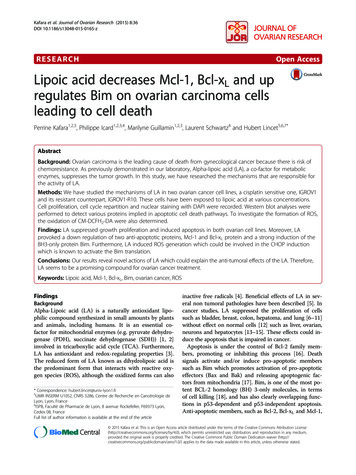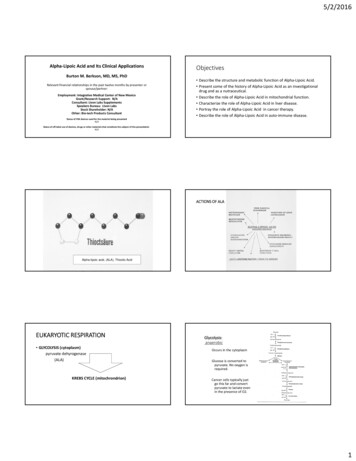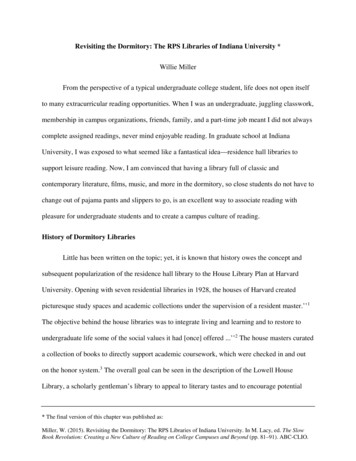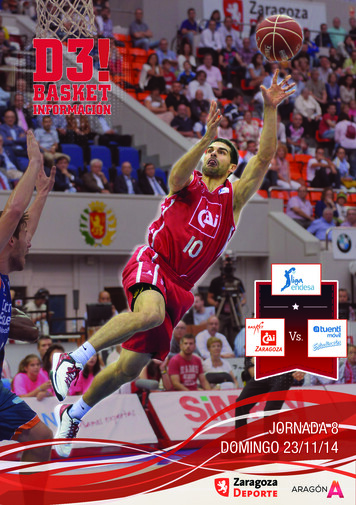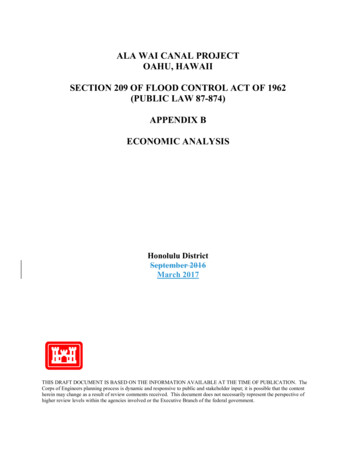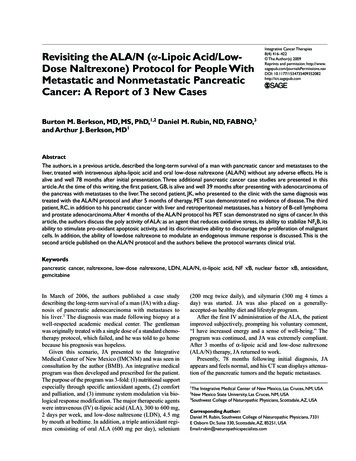
Transcription
Revisiting the ALA/N (α-Lipoic Acid/LowDose Naltrexone) Protocol for People WithMetastatic and Nonmetastatic PancreaticCancer: A Report of 3 New CasesIntegrative Cancer Therapies8(4) 416–422 The Author(s) 2009Reprints and permission: http://www.sagepub.com/journalsPermissions.navDOI: on M. Berkson, MD, MS, PhD,1,2 Daniel M. Rubin, ND, FABNO,3and Arthur J. Berkson, MD1AbstractThe authors, in a previous article, described the long-term survival of a man with pancreatic cancer and metastases to theliver, treated with intravenous alpha-lipoic acid and oral low-dose naltrexone (ALA/N) without any adverse effects. He isalive and well 78 months after initial presentation. Three additional pancreatic cancer case studies are presented in thisarticle. At the time of this writing, the first patient, GB, is alive and well 39 months after presenting with adenocarcinoma ofthe pancreas with metastases to the liver. The second patient, JK, who presented to the clinic with the same diagnosis wastreated with the ALA/N protocol and after 5 months of therapy, PET scan demonstrated no evidence of disease. The thirdpatient, RC, in addition to his pancreatic cancer with liver and retroperitoneal metastases, has a history of B-cell lymphomaand prostate adenocarcinoma. After 4 months of the ALA/N protocol his PET scan demonstrated no signs of cancer. In thisarticle, the authors discuss the poly activity of ALA: as an agent that reduces oxidative stress, its ability to stabilize NFkB, itsability to stimulate pro-oxidant apoptosic activity, and its discriminative ability to discourage the proliferation of malignantcells. In addition, the ability of lowdose naltrexone to modulate an endogenous immune response is discussed. This is thesecond article published on the ALA/N protocol and the authors believe the protocol warrants clinical trial.Keywordspancreatic cancer, naltrexone, low-dose naltrexone, LDN, ALA/N, α-lipoic acid, NF κB, nuclear factor κB, antioxidant,gemcitabineIn March of 2006, the authors published a case studydescribing the long-term survival of a man (JA) with a diagnosis of pancreatic adenocarcinoma with metastases tohis liver.1 The diagnosis was made following biopsy at awell-respected academic medical center. The gentlemanwas originally treated with a single dose of a standard chemotherapy protocol, which failed, and he was told to go homebecause his prognosis was hopeless.Given this scenario, JA presented to the IntegrativeMedical Center of New Mexico (IMCNM) and was seen inconsultation by the author (BMB). An integrative medicalprogram was then developed and prescribed for the patient.The purpose of the program was 3-fold: (1) nutritional supportespecially through specific antioxidant agents, (2) comfortand palliation, and (3) immune system modulation via biological response modification. The major therapeutic agentswere intravenous (IV) α-lipoic acid (ALA), 300 to 600 mg,2 days per week, and low-dose naltrexone (LDN), 4.5 mgby mouth at bedtime. In addition, a triple antioxidant regimen consisting of oral ALA (600 mg per day), selenium(200 mcg twice daily), and silymarin (300 mg 4 times aday) was started. JA was also placed on a generallyaccepted-as healthy diet and lifestyle program.After the first IV administration of the ALA, the patientimproved subjectively, prompting his voluntary comment,“I have increased energy and a sense of well-being.” Theprogram was continued, and JA was extremely compliant.After 3 months of α-lipoic acid and low-dose naltrexone(ALA/N) therapy, JA returned to work.Presently, 78 months following initial diagnosis, JAappears and feels normal, and his CT scan displays attenuation of the pancreatic tumors and the hepatic metastases.1The Integrative Medical Center of New Mexico, Las Cruces, NM, USANew Mexico State University, Las Cruces, NM, USA3Southwest College of Naturopathic Physicians, Scottsdale, AZ, USA2Corresponding Author:Daniel M. Rubin, Southwest College of Naturopathic Physicians, 7331E Osborn Dr, Suite 330, Scottsdale, AZ, 85251, USAEmail:rubin@naturopathicspecialists.com
417Berkson et alIn September of 2007, the same authors published a casestudy of a 61-year-old man with non-Hodgkins lymphoma.2He refused standard therapy for religious reasons. On presentation, he had baseball-sized lymph nodes in his cervicalregion and left groin as demonstrated by a PET scan; onenode contained biopsy-proven malignancy. After 6 monthsof LDN therapy and only 2 weeks of IV ALA, a PET scandemonstrated radiological remission; at the time of thiswriting, he is still free of disease, 57 months after his diagnosis date.The impact of our initial publication has caused severalother patients with pancreatic cancer to present to theIMCNM requesting access to the ALA/N protocol. Some ofthe more recent case studies are presented here.Patient 1: GBMrs GB is a 74-year-old Californian woman who was diagnosed with gall-stone pancreatitis in 1996. She recoveredfrom her symptoms and was placed on maintenance therapy. She had no further symptoms until presentation inFebruary of 2006, when during physical exam, a mass waspalpated in her epigastric region. A CT scan demonstratedboth a large mass in the head of her pancreas as well assome hepatic parenchymal abnormalities, thought to represent metastatic deposits.Soon thereafter, a fine-needle aspirate of the pancreasdemonstrated mucinous adenocarcinoma. Despite her physicians’ urging to quickly begin an intensive chemotherapeuticregimen, she declined because her religious beliefs precluded such a regimen. Subsequently, she was given aprognosis of 3 to 6 months of life if she did not undergo theproposed chemotherapy treatments.Mrs GB’s friend had read about the ALA/N protocoland suggested that she try the approach because she wasleft with no other reasonable treatment opportunities. GBcame to the IMCNM in September 2006 with complaintsof only accelerating and profound chronic fatigue andabdominal pain. On physical exam GB was rather thin andpale, and a large mass was palpated in her upper abdomen.Her Carcinoembryonic Antigen (CEA) was 6.7 and herCarbohydrate Antigen 19-9 (CA 19-9) was 39.A PET scan was then performed demonstrating a nodular focus of enhanced glucose metabolism in the right upperquadrant of the abdomen with numerous hypermetabolicareas in the liver (Figure 1). BMB did address the standardof-care approach for her disease, which the patient againpromptly declined. She was offered ALA/N, consented tosuch, and the treatment was initiated.As the treatment regimen continued, Mrs. GB was followed carefully with periodic laboratory and physicalexams. She continued to improve in all parameters: serologically, physically, and symptomatically. By February2007 and again in March 2008, GB was declared to be inFigure 1. Mrs GB September, 2006radiological remission by PET surveillance (Figures 2 and3). Serologically, her CEA and CA 19-9 both normalizedfrom 6.7 to 0.9 and from 39 to 18, respectively. At the timeof this writing, 39 months after her diagnosis, GB continueswith her treatment plan and has no signs of pancreaticdisease.Patient 2: JKJK is an 80-year-old woman with generalized atherosclerotic vascular disease, diagnosed with adenocarcinoma ofthe pancreas with possible metastatic disease of the liver inSeptember of 2005. Several months earlier, she began tofeel very tired, developed nausea, and started to loseweight. Her general internist sent her to a gastroenterologist who ordered a CT scan and diagnosed a large lesion inthe head of the pancreas with other lesions in the liverthought to be metastatic from the pancreas. A biopsy wasperformed on the pancreatic tumor in December 2005, andthe pathology lab reported that it had missed the cancer.Mrs JK had a further workup at an academic hospital, andshe was told that in spite of the negative biopsy, she hadpancreatic cancer and was given a grim prognosis. No further treatment was suggested because of her advanced age.JK’s family doctor, who was familiar with the innovativeoncology literature, suggested that she try a nonstandardapproach for her illness. She came to the IMCNM in January of 2006.
418Figure 2. Mrs GB February, 2007Figure 3. Mrs GB March 2008JK had to be helped by her friend into the exam roombecause she was too weak to walk and stand by herself. Onphysical exam, she was found to be cachetic and pale. Herskin was jaundiced and her sclerae were icteric. Her lungsIntegrative Cancer Therapies 8(4)Figure 4. Mrs JK January 2006were clear, and her heart had normal sounds and rhythm. Alarge mass was easily palpated in her epigastric region.January 2006 laboratory results showed leucopenia,anemia, abnormal liver function, hyperglycemia, and a CA19-9 of 353. A PET scan was performed and showed a largemass in the head of the pancreas with possible metastaticdisease in the liver (Figure 4). The various standard treatment options were explained; however, JK stated her desireto delay such and in their place undergo the ALA/Nprotocol.As the treatment regimen was initiated and continued,JK was followed carefully with periodic laboratory andphysical exams. She continued to put on weight and havedemonstrable serological improvement. In late June 2006(5 months after her initial visit), a repeat PET scan was performed, this time demonstrating no signs of pancreaticadenocarcinoma (Figure 5). Mrs JK continued her treatmentprogram, and her health was maintained, symptom free.In July of 2006, JK returned to her home in Californiaand stopped her ALA/N treatment regimen. By August2006, she began to feel ill once more; a CT scan was performed, which showed that the pancreatic adenocarcinomahad indeed returned. She expired in November 2006, 14months following initial diagnosis.Patient 3: RCRC, a 67-year-old male was conventionally treated forprostate cancer with brachytherapy in 1996. In 1998, RC
419Berkson et alFigure 5. Mrs JK June 2006developed abdominal pain and was diagnosed with a diffuse large-cell lymphoma of B-cell origin. He was treatedwith 6 cycles of CHOP (cyclophosphamide, doxorubicin,vincristine, and prednisone) and radiation therapy.RC developed painless jaundice in May of 2006 secondary to a distal, common bile duct obstruction. Exploratorysurgery was performed revealing a nonresectable pancreatic carcinoma. He underwent a choledochoduodenostomywith gastrojejunostomy. The postoperative course becamecomplicated by an abdominal infection requiring drainageand multiple courses of antibiotics. His external percutaneous biliary drain was never fully functional, resulting inrecurrent episodes of cholangitis.RC went to a large medical center in San Diego for asecond opinion. A CT scan was performed, and it demonstrated pancreatic cancer, liver metastases, and peritonealcarcinomatosis. RC, too, was told that treatment would mostlikely yield little therapeutic benefit and that no treatmentmay be the favorable choice for him overall.RC arrived at the IMCNM in November 2006. He wasemaciated and appeared in generally poor health. His CEAwas 5.8 and his CA 19-9 was 53.6. A PET scan was performed, which showed hypermetabolic retroperitoneallesions, both to the left and right, indicative of a large pancreatic tumor with numerous metastases to the liver(Figure 6). He was told that his disease process was welladvanced and that an ALA/N protocol would be developed that could possibly prolong his life. Opting for this,RC was started on LDN 4.5 mg each night before bedalong with IV ALA.Figure 6. Mr RC November 2006RC continued the ALA/N until February 2007 whenanother PET scan was performed. It showed a resolutionof the previously demonstrated pancreatic and retroperitoneal lesions (Figure 7). RC was feeling so good that he wasscheduled to have an internalization of the percutaneousbiliary drain in March of 2007. He was examined by a medical oncologist who commented that at this point, RC hadrelatively little in the way of symptoms to palliate. The internalization of the biliary drain was performed, and on hismedical oncologist’s recommendation, he began a course ofgemcitabine. Just before starting chemotherapy, his CEAhad fallen from 53.6 to 2.6 and his CA 19-9 dropped from146 to 113. His severe abdominal pain returned and becauseof the need for narcotics, RC was taken off his LDN. Hesoon developed septicemia, became unresponsive, andexpired in May 2007, 12 months after initial diagnosis.DiscussionIn general, patients with advanced carcinoma of the pancreashave a very poor prognosis. The usual length of survivalfollowing initial diagnosis ranges from 3 to 6 months. Incertain cases, surgical intervention is not an option, andpatients with advanced disease rarely live more than a fewweeks. The current view is that treatment should concentrateon palliative management.3JA was a patient with biopsy-proven adenocarcinoma ofthe pancreas with metastases to the liver that we started
420Integrative Cancer Therapies 8(4)the IMCNM with cachexia, jaundice, and abdominal pain.He desired ALA/N protocol for his recent malignancy. He,therefore, quickly weaned himself off of his narcotic andsubsequently began the LDN component. Soon after startingthe ALA/N protocol, RC began to feel better. He felt so goodthat he went to surgery to internalize his percutaneous biliary drain. Following surgery, he developed septicemia anddied in May of 2007, 12 months following the diagnosis ofpancreatic cancer.The authors believe that the stability of the patient’s disease is attributable to the ALA/N protocol developed byBMB. This is substantiated by our initial report in 2005, onpatient JA.1These cases all represent, at the least, a reinstatement ofa high quality of life for all patients who presented withpancreatic cancer. Such an achievement places the ALA/Nprotocol as a promising new treatment for people with thisdisease.α-Lipoic AcidFigure 7. Mr RC PET scan February 2007treating with the ALA/N protocol in November 2002.1 Justprior to this, and after 1 round of chemotherapy, JA was toldby a reputable academic medical center that there was littlehope for his survival. His progress is being followed by CTscans and PET scans, and he has done very well on theALA/N protocol. Presently, 78 months after his initial presentation, he is back at work, free from symptoms, andwithout progression of his disease.GB was diagnosed with pancreatic cancer in February of2006. She refused the standard therapies because of religious reasons. She was started on the ALA/N protocol and isalive and free of signs and symptoms 39 months after initialdiagnosis.JK was diagnosed with pancreatic carcinoma with metastases to the liver in September of 2005. When she arrived atthe clinic in January of 2006, her quality of life was poor.She was jaundiced and appeared cachectic. She was physically and emotionally exhausted, and complained of constantabdominal pain and nausea. After a few weeks of ALA/Ntherapy, her symptoms began to improve, and 9 months afterdiagnosis and 6 months following the initiation of therapy,her PET scan failed to demonstrate disease recurrence. Duringthis period of 6 months, she felt essentially normal, withoutpain or nausea. After returning to her home state, her doctorsrefused to continue the ALA/N protocol. She subsequentlyhad a brisk disease recurrence and succumbed to such inNovember 2006, 14 months following initial diagnosis.RC carried the diagnoses of 3 primary malignancies:prostate adenocarcinoma, non-Hodgkin’s lymphoma, andfinally, pancreatic adenocarcinoma. He initially presented toALA is the first component in the protocol. It is a naturallyoccurring cofactor that is active in an assortment of enzymecomplexes that control metabolism, including the conversion of pyruvate to energy in the mitochondrion. ALA isalso a vigorous free radical scavenger that has demonstratedthe ability to reduce oxidative stress in a number of disorders, including diabetes, liver disease, and cancer.There have been a number of articles suggesting the useof ALA in the treatment of various cancers. One articlereported that ALA induced hyperacetylation of histones.Histones are proteins that are active in the proliferation ofmany types of cancer cells. Inhibition of such can drive a celltoward the apoptotic cascade. In this study, human cancercell lines became apoptotic after being exposed to ALA,whereas the same treatment of normal cell lines did not induceapoptosis.4Another mechanism whereby ALA may discourage thegrowth of cancer cells is its ability to stabilize NF κB(nuclear factor κB).5 Under normal circumstances, NF κBdimers reside in the cytoplasm. However, if activated, theprotein complex will translocate into the nucleus. On activation, it will launch the induction of more than 200 genesdemonstrated to suppress apoptosis (create increased survival) and induce cellular transformation, proliferation,invasion, metastasis, chemoresistance, radio resistance,and inflammation.6 NF κB is a current and future target inoncology treatment. Modern pharmacological treatmenthas pointed toward NF κB, in that bortezomib, a novelproteasome inhibitor, inhibits NF κB as one of its valueddemonstrations.Additionally, Th1- and Th2-mediated immune systemcells react to pathogenic insults with various cell membranous receptors. Many of these receptors start a cascade of
421Berkson et alevents that activate transcription factor NF κB.5 Becauseof this, NF κB plays a significant role in the regulation ofinflammatory-induced gene function. High doses of ALA,when added to cell culture have been shown to inhibit theactivation of NF κB.7Another article showed evidence of a mechanism bywhich ALA might be helpful in cancer therapy because ofthe fact that it can stimulate prooxidant-driven apoptosisin human colon cancer cells. This process is activated byan increased uptake of oxidizable substrates into the mitochondrion.8 In another study, ALA was shown to increasehomocysteine concentrations within cancer cells in certainestablished cancer cell lines.9 The increased homocysteineconcentrations were toxic for the malignant cells. An additional publication reported that ALA helped the proliferationof normal human lymphocytes and slowed down the proliferation of 2 leukemic T-cell lines.10 The discriminatingtoxicity of ALA was because of the induction of apoptosisin the leukemia cells. ALA also noticeably increased theinduction of interleukin-2 (IL-2) mRNA and IL-2 proteinsecretion in cancer cells. The authors stated that the differential effects of ALA on normal and leukemic lymphocytesmay specify a new pathway toward the development oftherapeutic agents for cancer.Mantovani and Maccio11 demonstrated the ability of ALAto correct functional defects in peripheral blood mononuclear cells isolated from advanced stage cancer patients.Twenty patients with advanced cancers of the lung, ovary,endometrium, and head and neck were examined. The serumlevels of IL-1β, IL-2, IL-6, TNF-α, and sIL-2R were significantly higher in cancer patients than in patients with noknown cancers. The addition of ALA into the cell culturessignificantly increased the response of cancer patient mononuclear cells. This report demonstrated that ALA has abeneficial effect on immune cell function in advanced-stagecancer patients.NaltrexoneLDN was the second key ingredient in the therapy of thepatients. Nocturnally dosed LDN blocks endogenous opiatereceptors for a very short time. During this receptor blockade,the body produces large amounts of opiates in response tothe positive feedback. The endogenous opiates becomeavailable and saturate receptors on various cells in the immunesystem.In 1995, Bihari12 first used LDN to treat people withAIDS: given his promising results, he later used LDN forthe treatment of people with cancer. Over the years, headministered LDN to 450 patients with cancer, most ofwhom had failed the standard treatments. According toBihari, of 354 patients who had regular follow-ups, 86showed at least a 75% reduction in tumor bulk, and 125others were reported to have achieved remission or wereclose to remission.13Zagon and McLaughlin14 reported that LDN slowed thegrowth of neuroblastoma cells in culture and suggested thatit may have a role in the treatment of certain cancers.Malignant astrocytomas are not believed to be curable,and treatment is aimed at palliation. Lissoni et al15 reportedon the treatment of this malignancy with naltrexone plusradiotherapy (RT). The tumor regression rate in patientstreated with RT plus naltrexone was somewhat higher thanthose treated with RT alone, and the percentage of thosesurviving at 1 year was significantly higher in patientstreated with RT plus naltrexone than in those treated withRT alone.ConclusionWe are not certain if there is a synergistic or additive relationship between ALA and LDN. As of the time of thiswriting, there does not seem to be any directly common biochemical pathway. It is reasonable to think that there indeedis at least one of these effects or that their coadministrationinitiates a novel cascade of biological effects. It is reasonable to believe as well that one component of the ALA/Nprotocol bears greater therapeutic efficacy than the other. Itis reasonable that certain histological types of pancreaticcancer will respond to ALA/N. This is the second articlepublished on this subject, and we believe that this does warrant deeper clinical investigation via a clinical trial,especially given the poor clinical course often experiencedby those diagnosed with metastatic pancreatic cancer.In summary, the integrative therapy described in this article may have the possibility of extending the life of a patientwho is customarily considered terminal. This was accomplished with a program of an antioxidant that bears knownantitumor activity (namely, ALA) and an opiate blockadeagent that can stimulate an endogenous immune response.As we stated in our earlier article, we believe that biomedical science will one day develop a cure for metastaticpancreatic cancer, perhaps via gene therapy or another biological-type platform. But until such protocols come tomarket, moreover evolve and are realized, the ALA/N therapy should be considered, given its lack of toxicity at levelsreported herein, its ready availability, and its effect on the 4patients discussed in this current article.Declaration of Conflicting InterestsThe authors declared no conflicts of interest with respect to theauthorship and/or publication of this article.FundingThe authors received no financial support for the research and/orauthorship of this article.
422References1. Berkson, BM, Rubin D, Berkson AJ. The long-term survivalof a patient with pancreatic cancer with metastases to theliver after treatment with the intravenous alpha-lipoic acid/low-dose naltrexone protocol. Integr Cancer Ther. 2006;5:83-89.2. Berkson, BM, Rubin D, Berkson AJ. Reversal of signs andsymptoms of a B-cell lymphoma in a patient using only lowdose naltrexone. Integr Cancer Ther. 2007;6:293-296.3. Bornman P, Beckingham IJ. ABCs of diseases of liver, pancreas, and biliary system: pancreatic tumours. BMJ. 2001;322:721-723.4. Van de Mark K, Chen JS, Steliou K, et al. Alpha-lipoic acidinduces p27Kip-dependent cell cycle arrest in non-transformedcell lines and apoptosis in tumor cell lines. J Cell Physiol.2003;194:325-340.5. Lee KY, D’Acquisto F, Hayden MS, Shim JH, Ghosh S. PDK1nucleates T cell receptor-induced signaling complex for NFkappaB activation. Science. 2005;308:114-118.6. Aggarwal BB, Shishodia S. Molecular targets of dietaryagents for prevention and therapy of cancer. Biochem Pharmacol. 2006;71:1397-1421.7. Suzuki YJ, Aggarwal BB, Packer L. Alpha-lipoic acid is apotent inhibitor of NF-kappa B activation in human T cells.Biochem Biophys Res Commun. 1992;189:1709-1715.Integrative Cancer Therapies 8(4)8. Wenzel U, Nickel A, Daniel H. Alpha-lipoic acid inducesapoptosis in human colon cancer cells by increasing mitochondrial respiration with a concomitant O2-*-generation. Apoptosis. 2005;10:359-368.9. Hultberg B. Modulation of extracellular homocysteine concentration in human cell lines. Clin Chim Acta. 2003;330:151-159.10. Pack RA, Hardy K, Madigan MC, Hunt NH. Differentialeffects of the antioxidant alpha-lipoic acid on the proliferation of mitogen-stimulated peripheral blood lymphocytes andleukaemic T cells. Mol Immunol. 2002;38:733-745.11. Mantovani G, Maccio A. Restoration of functional defectsin peripheral blood mononuclear cells isolated from cancerpatients by thiol antioxidants alpha-lipoic acid and N-acetylcysteine. Int J Cancer. 2000;86:842-847.12. Bihari B. LDN and cancer. http://www.lowdosenaltrexone.org/ldn and cancer.htm. Accessed December 8, 2005.13. Bihari B. Keynote address. Presented at: first annual LowDose Naltrexone Conference at the New York Academy ofSciences; June 11, 2005; New York, NY.14. Zagon IS, McLaughlin PJ. Naltrexone modulates tumor responsein mice with neuroblastoma. Science. 1983;221:671-673.15. Lissoni P, Meregalli S, Fossati V, et al. Radioendocrine therapyof brain tumors with the long acting opioid antagonist naltrexone in association with radiotherapy. Tumori. 1993;79:198-201.
Cancer: A Report of 3 New Cases Burton M. Berkson, MD, MS, PhD,1,2 Daniel M. Rubin, ND, FABNO,3 and Arthur J. Berkson, MD1 Abstract The authors, in a previous article, described the long-term survival of a man with pancreatic cancer and metastases to the


